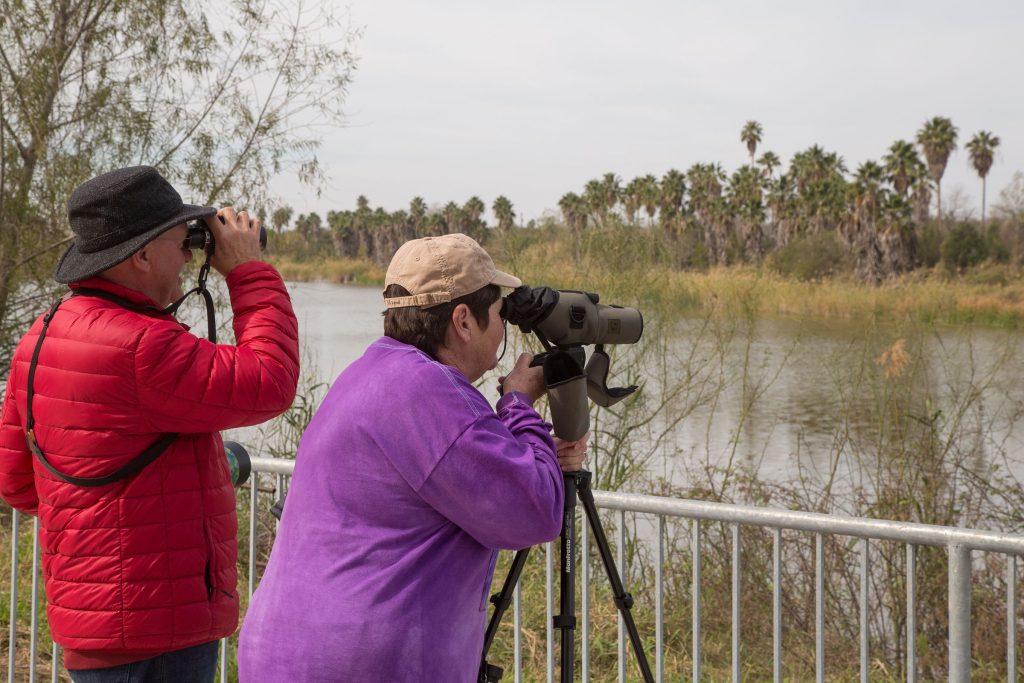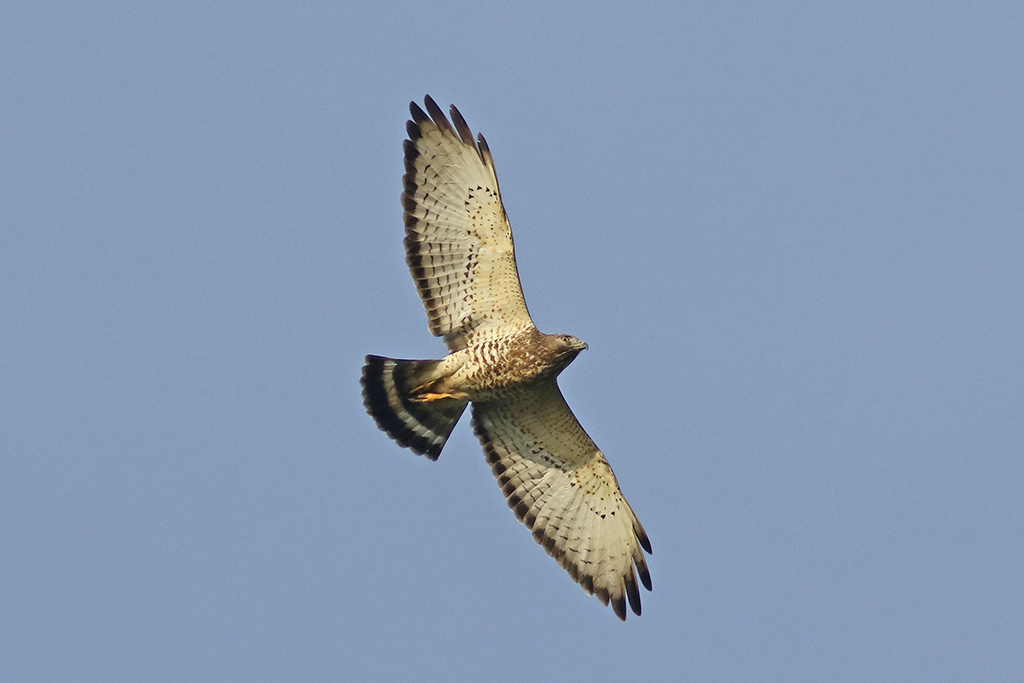
Hawk watchers at Bentsen Rio Grande Valley State Park. Photo by Will van Overbeek
The Texas State Parks system marks its 100th anniversary this year. With 89 parks, natural areas, and historic sites to choose from, visitors can experience all kinds of outdoor activities. Each month, we’re highlighting one of these activities based on the season and special occasions around the state.
On a two-story wooden tower rising above a tangle of trees and shrubs, a group of people train binoculars up at hundreds of specks circling high in the clear sky. The specks are migrating hawks—a type of raptor or bird of prey—and thousands of them pass over Bentsen-Rio Grande Valley State Park every spring and fall.
Hawk Watch
Address: 2800 S. Bentsen Palm Drive (FM 2062)
Phone: 956-584-9156
Hours: Every day from 9 to 11 a.m. in March and April
Park Entry Fee: $5 for adults; free for 12 and under
Website: tpwd.texas.gov/state-parks/bentsen-rio-grande-valley
Tips: Volunteers and naturalists help visitors spot, identify, and count migrating raptors. Bring binoculars, a hat, sunscreen, insect repellent, and drinking water.
With a mix of wetland, brush, and woodland habitats lining the Rio Grande, this park lies south of the town of Mission about 13 miles from McAllen and 70 miles from Brownsville.
“There are mountains to the west of us and the Gulf of Mexico to the east, and we are on the central and Mississippi flyways, so birds migrating to or from the eastern United States all come through South Texas on their migration route,” says Roy Rodriguez, who as a park interpreter talks to visitors about the natural environment at the park, including the hawks.”
Species like hawks often fly in huge flocks or aggregations, he adds, and they travel long distances by using rising air currents called thermals. “They catch thermals and ride them up as high as they can, then glide as far as they can and catch another updraft. Under the right conditions, a bird can move 200 miles a day without flapping its wings.”
According to Rodriguez, there can be hundreds of birds circling in one thermal, forming what is known as a kettle. “It starts warming up around 9 a.m. here at the park, and that’s when we try to count them,” he says. “As they move from one thermal to the next, they do it in a follow-the-leader kind of way, which makes it easier.”
From the first day of March to the last day of April, the park hosts an official Hawk Count, where volunteers count the birds of prey and submit the numbers to a long-term study of raptor population trends in North America. Birds of prey are good indicators of overall environmental health, so ups and downs in their numbers are useful to scientists and those who manage natural areas.
Volunteer count master John Kaye coordinates the park’s count and is on the tower most days (he is even featured in a short documentary about hawk migration by Mexican filmmaker Otilia Portillo Padua, who discusses the project here). Kaye stresses that counting is not required—anyone is welcome to come and hang out on the tower and just look for hawks. He is also happy to answer questions.
“I try to bring it to a person’s level, whether they are an experienced birder, a beginner, or someone who hasn’t ever birded,” he says. However, he cautions that most people won’t always get a close look at the hawks.
“Most of the birds when they first come up from the woods are a quarter to a half mile away, so you are getting long-distance views,” he says. “What makes it interesting is when they fly directly over our heads—that’s as good as it gets. And we see significant numbers. We might get thousands in a kettle.”

A very common migrant hawk in spring, the Broad-winged Hawk (Buteo platypterus) is the most frequently counted raptor during Hawk Watch. Photo by Bill Supulski
Binoculars provide a closer look, and the park rents them out to visitors for $3 a day. Kaye will help visitors identify specific hawks and talk about the behavior and other background of a species. The best chance to see birds is from the fourth week of March through the second or third week of April, he says.
Rodriguez recalls one season where 75,000 broad-winged hawks came through the park in two weeks. “We have migrants passing through to spend winter in Central and South America,” he says. “But we also have local resident raptors. You never know what will pop up. People look for hook-billed kites, the rarest and hardest to find of local breeding birds. They eat snails and when we have a lot of those, you see a lot of the kites. The prairie falcon is another that sometimes pops up, and there are lots of water birds up there with the hawks.”
The Hawk Tower has a 210-foot-long wheelchair-accessible ramp and provides views of the park and nearby Mexico. Part of the World Birding Center, this park is home to more than 300 other bird species, both migrating and those that remain year-round. Because the park does not allow cars, you’ll need to leave your car at the park headquarters and then walk or bike (available to rent at the park). The park has 7 miles of trail, including 3.5 miles of paved road. There’s also a tram that runs hourly from 9 a.m. to 4 p.m. For a longer stay, the Bentsen-Rio Grande Valley has campsites, a 15-acre fishing lake, bird blinds, nature center, a store, and cafe.








